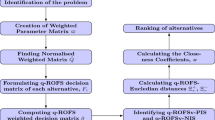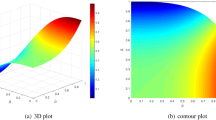Abstract
The recently proposed q-rung orthopair fuzzy set (q-ROFS) is a powerful and effective tool to describe uncertainty and vagueness, and Hamy mean (HM) has a significant advantage of capturing the interrelationship among aggregated arguments. In order to take full advantage of q-ROFS and HM, and consider the interactions between membership and non-membership degrees at the same time, in this paper, we propose a family of q-rung orthopair fuzzy Hamy mean operators based on interaction operations. First, we define interaction operational rules for q-rung orthopair fuzzy numbers. Based on the new operational rules, q-rung orthopair fuzzy interaction HM and q-rung orthopair fuzzy interaction weighted HM operators are proposed. Further, we propose a dual Hamy mean (DHM) operator and extend it to accommodate q-rung orthopair fuzzy environment. Based on interaction operational rules and DHM, q-rung orthopair fuzzy interaction DHM operator and its weighted form are also developed. Then, a novel multi-attribute group decision-making approach based on proposed operators is introduced. Finally, a numerical instance, as well as some comparative analyses, is provided to illustrate the validity and advantages of the new approach.


Similar content being viewed by others
References
Yager RR (2014) Pythagorean membership grades in multi-criteria decision making. IEEE Trans Fuzzy Syst 22(4):958–965
Atanassov KT (1986) Intuitionistic fuzzy sets. Fuzzy Sets Syst 20(1):87–96
Garg H (2016) A novel correlation coefficients between Pythagorean fuzzy sets and its applications to decision making processes. Int J Intell Syst 31(12):1234–1252
Zeng WY, Li DQ, Yin Q (2018) Distance and similarity measures of Pythagorean fuzzy sets and their applications to multiple criteria group decision making. Int J Intell Syst 33(11):2236–2254
Biswas A, Sarkar B (2018) Pythagorean fuzzy multicriteria group decision making through similarity measure based on point operators. Int J Intell Syst 33(18):1731–1740
Wei GW, Wei Y (2018) Similarity measures of Pythagorean fuzzy sets based on the cosine function and their applications. Int J Intell Syst 33(18):634–652
Li DQ, Zeng WY (2018) Distance measure of Pythagorean fuzzy sets. Int J Intell Syst 33(2):348–361
Peng XD, Dai JG (2017) Approaches to Pythagorean fuzzy stochastic multi-criteria decision making based on prospect theory and regret theory with new distance measure and score function. Int J Intell Syst 32(11):1187–1214
Zhang XL, Xu ZS (2014) Extension of TOPSIS to multiple criteria decision making with Pythagorean fuzzy sets. Int J Intell Syst 29(12):1061–1078
Ren PJ, Xu ZS, Gou XJ (2016) Pythagorean fuzzy TODIM approach to multi-criteria decision making. Appl Soft Comput 42:246–259
Perez-Dominguez L, Rodriguez-Picon LA, Alvarado-Iniesta A, Cruz DL, Xu ZS (2018) MOORA under Pythagorean fuzzy set for multiple criteria decision making. Complexity. https://doi.org/10.1155/2018/2602376
Khan MSA, Abdullah S, Ali A, Siddiqui N, Amin F (2017) Pythagorean hesitant fuzzy sets and their application to group decision making with incomplete weight information. J Intell Fuzzy Syst 33(6):3971–3985
Khan MSA, Abdullah S (2018) Interval-valued Pythagorean fuzzy GRA method for multiple-attribute decision making with incomplete weight information. Int J Intell Syst 33(8):1689–1716
Garg H (2018) Linguistic Pythagorean fuzzy sets and its applications in multiattribute decision-making process. Int J Intell Syst 33(6):1234–1263
Peng XD, Selvachandran G (2017) Pythagorean fuzzy set: state of the art and future directions. Artif Intell Rev. https://doi.org/10.1007/s10462-017-9596-9
Ma ZM, Xu ZS (2016) Symmetric Pythagorean fuzzy weighted geometric/averaging operators and their application in multicriteria decision-making problems. Int J Intell Syst 31(12):1198–1219
Garg H (2017) Generalized Pythagorean fuzzy geometric aggregation operators using Einstein t-norm and t-conorm for multi-criteria decision making process. Int J Intell Syst 32(6):597–630
Garg H (2016) A new generalized Pythagorean fuzzy information aggregation using Einstein operations and its application to decision making. Int J Intell Syst 31(9):886–920
Rahman K, Abdullah S, Ahmed R et al (2017) Pythagorean fuzzy Einstein weighted geometric aggregation operator and their application to multiple attribute group decision making. J Intell Fuzzy Syst 33(1):1–13
Wei GW (2017) Pythagorean fuzzy interaction aggregation operators and their application to multiple attribute decision making. J Intell Fuzzy Syst 33:2119–2132
Gao H, Lu M, Wei GW (2018) Some novel Pythagorean fuzzy interaction aggregation operators in multiple attribute decision making. Fund Inform 159:385–428
Liang DC, Zhang YR, Xu ZS et al (2018) Pythagorean fuzzy Bonferroni mean aggregation operator and its accelerative calculating algorithm with the multithreading. Int J Intell Syst 33(3):615–633
Liang DC, Xu Z, Darko AP (2017) Projection model for fusing the information of Pythagorean fuzzy multicriteria group decision making based on geometric Bonferroni mean. Int J Intell Syst 32(9):966–987
Zhang RT, Wang J, Zhu XM, Xia MM, Yu M (2017) Some generalized Pythagorean fuzzy Bonferroni mean aggregation operators with their application to multiattribute group decision-making. Complexity 5:4. https://doi.org/10.1155/2017/5937376
Wei GW, Lu M (2018) Pythagorean fuzzy Maclaurin symmetric mean operators in multiple Attribute decision making. Int J Intell Syst 33(5):1043–1070
Qin JD (2018) Generalized Pythagorean fuzzy maclaurin symmetric means and its application to multiple attribute SIR group decision model. Int J Fuzzy Syst 20(3):943–957
Yang W, Pang YF (2018) New Pythagorean fuzzy interaction Maclaurin symmetric mean operators and their application in multiple attribute decision making. IEEE Access 6:39241–39260
Yager RR (2018) Generalized orthopair fuzzy sets. IEEE Trans Fuzzy Syst 26(5):1222–1230
Liu PD, Wang P (2017) Some q-rung orthopair fuzzy aggregation operators and their applications to multi-attribute group decision making. Int J Intell Syst 33(2):259–280
Liu PD, Liu JL (2018) Some q-rung orthopair fuzzy Bonferroni mean operators and their application to multi-attribute group decision making. Int J Intell Syst 33(2):315–347
Wei GW, Gao H, Wei Y (2018) Some q-rung orthopair fuzzy Heronian mean operators in multiple attribute decision making. Int J Intell Syst 33(7):1426–1458
Peng XD, Dai JG, Garg H (2018) Exponential operation and aggregation operator for q-rung orthopair fuzzy set and their decision-making method with a new score function. Int J Intell Syst 33(11):2255–2282
Liu ZM, Liu PD, Liang X (2018) Multiple attribute decision-making method for dealing with heterogeneous relationship among attributes and unknown attribute weight information under q-rung orthopair fuzzy environment. Int J Intell Syst 33(9):1900–1928
He YD, Chen HY, Zhou LG et al (2014) Intuitionistic fuzzy geometric interaction averaging operators and their application to multi-criteria decision making. Inf Sci 259:142–159
He YD, Chen HY, Zhou LG et al (2014) Generalized intuitionistic fuzzy geometric interaction operators and their application to decision making. Expert Syst Appl 41:2484–2495
Hara T, Uchiyama M, Takahasi SE (1998) A refinement of various mean inequalities. J Inequal Appl 2(4):387–395
Yu DJ (2013) Intuitionistic fuzzy geometric Heronian mean aggregation operators. Appl Soft Comput 13(2):1235–1246
Liu PD, Chen SM (2017) Group decision making based on Heronian aggregation operators of intuitionistic fuzzy numbers. IEEE Trans Cybern 99:2514–2530
Qin JD (2017) Interval type-2 fuzzy Hamy mean operators and their application in multiple criteria decision making. Granul Comput 2:249–269
Liu PD, You XL (2018) Some linguistic neutrosophic Hamy mean operators and their application to multi-attribute group decision making. PLoS ONE 13(3):e0193027
Liu PD, Chen SM, Liu JL (2017) Multiple attribute group decision making based on intuitionistic fuzzy interaction partitioned Bonferroni mean operators. Inf Sci 411:98–121
Xu ZS (2007) Intuitionistic fuzzy aggregation operators. IEEE Trans Fuzzy Syst 15(6):1179–1187
Xu ZS, Yager RR (2011) Intuitionistic fuzzy Bonferroni means. IEEE Trans Syst Man Cy B 41(2):568–578
Qin JD, Liu XW (2014) An approach to intuitionistic fuzzy multiple attribute decision making based on Maclaurin symmetric mean operators. J Intell Fuzzy Syst 27(5):2177–2190. https://doi.org/10.3233/ifs-141182
He YD, He Z, Chen HY (2015) Intuitionistic fuzzy interaction Bonferroni means and its application to multiple attribute decision making. IEEE Trans Cybernet 45(1):116–128
Sarkoci P (2005) Domination in the families of Frank and Hamacher t-norms. Kybernetika 41(3):349–360
Dombi J (1982) A general class of fuzzy operators, the demorgan class of fuzzy operators and fuzziness measures induced by fuzzy operators. Fuzzy Sets Syst 8:149–163
Garg H (2016) A new generalized improved score function of interval-valued intuitionistic fuzzy sets and applications in expert systems. Appl Soft Comput 38:988–999
Khan MSA, Abdullah S, Ali MY et al (2018) Extension of TOPSIS method base on Choquet integral under interval-valued Pythagorean fuzzy environment. J Intell Fuzzy Syst. 34(1):267–282
Akram M, Shahzadi S (2018) Novel intuitionistic fuzzy soft multiple-attribute decision-making methods. Neural Comput Appl 29(7):435–447
Arora R, Garg H (2018) Prioritized averaging/geometric aggregation operators under the intuitionistic fuzzy soft set environment. Sci Iran 25(1):466–482. https://doi.org/10.24200/sci.2017.4410
Wan SP, Lin LL, Dong JY (2017) MAGDM based on triangular Atanassov’s intuitionistic fuzzy information aggregation. Neural Comput Appl 28(9):2687–2702
Acknowledgement
This work was partially supported by a key program of the National Natural Science Foundation of China (No. 71532002), Fundamental Funds for Humanities and Social Sciences of Beijing Jiaotong University (No. 2016JBZD01) and Fundamental Research Funds for the Central Universities (No. 2019YJS055).
Author information
Authors and Affiliations
Corresponding author
Ethics declarations
Conflict of interest
The authors declare that they have no conflict of interest.
Additional information
Publisher's Note
Springer Nature remains neutral with regard to jurisdictional claims in published maps and institutional affiliations.
Rights and permissions
About this article
Cite this article
Xing, Y., Zhang, R., Wang, J. et al. A new multi-criteria group decision-making approach based on q-rung orthopair fuzzy interaction Hamy mean operators. Neural Comput & Applic 32, 7465–7488 (2020). https://doi.org/10.1007/s00521-019-04269-8
Received:
Accepted:
Published:
Issue Date:
DOI: https://doi.org/10.1007/s00521-019-04269-8




